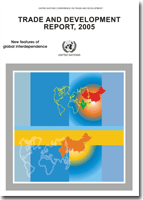
From the perspective of the Millennium Development Goals, it is good news that in 2004 per capita incomes grew almost everywhere in the developing world, and that short-term prospects are favourable. The bad news is that in sub-Saharan Africa even GDP growth of close to 5 per cent is still insufficient to attain the MDGs.
The global outlook for 2005 and beyond is overshadowed by increasing global trade imbalances. How can these be corrected without a worldwide recession? The solution has to build on higher domestic demand in Europe and Japan, but a coordinated international macroeconomic approach that includes the major developing countries is also needed.
Surging oil prices will have a stronger impact on economic activity and inflation in developing countries than in developed ones. However, most developing countries may be able to avoid new trade deficits as long as their own exports benefit from higher demand.
Since 2002, strong demand from East and South Asia, in particular China and India, has been the main factor behind the rise in commodity prices and the improved terms of trade of many developing countries. But how long will this continue?
The recent boom in the markets for certain primary commodities does not spell the end of the long-term declining trend and the instability of most commodity prices. Now is not the time for complacency about the commodity problem. On the contrary, developing countries must seize the opportunity to increase investment in manufacturing in order to achieve higher productivity and greater diversification.



